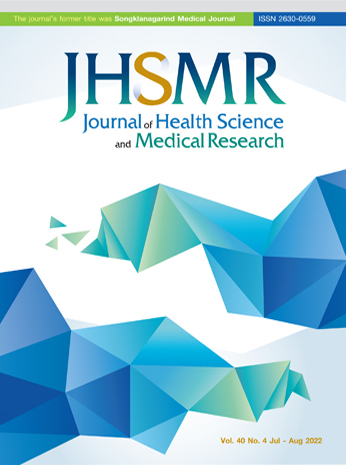Correlation of Uric Acid with Oxidative Stress and Endothelial Dysfunction in Type 2 Diabetes Mellitus
DOI:
https://doi.org/10.31584/jhsmr.2021850Keywords:
ferric reducing ability of plasma, malondialdehyde, nitric oxide, type 2 diabetes mellitus, uric acidAbstract
Objective: To evaluate the correlation of uric acid with oxidative stress and endothelial dysfunction in type 2 diabetic subjects.
Material and Methods: The study included 120 subjects, among them 60 were type 2 diabetes subjects and the remaining 60 were age and gender matched healthy controls. The biochemical parameters, blood glucose, lipid profile, uric acid and homocysteine, were measured by standard kits in an autoanalyzer. Oxidative stress was evaluated by measuring malondialdehyde (MDA) and total antioxidant power by manual methods such as thio-barbituric acid reactive substances and ferric reducing ability of plasma (FRAP). Endothelial dysfunction was assessed by measuring nitric oxide (NO) by the kinetic cadmium method.
Results: A significant elevation of triglycerides, low density lipoprotein (LDL), and MDA were observed in the type 2 diabetes mellitus patients while FRAP and NO were significantly reduced compared to the healthy controls. In addition, the uric acid levels had a highly significant correlation with FRAP (r=0.212, p-value=0.020), and moderately significant correlation with triglycerides (r=0.173, p-value=0.057) and homocysteine (r=0.178, p-value=0.051). Uric acid was negatively correlated with MDA and positively correlated with NO, but not statistically significant.
Conclusion: Our findings suggest that uric acid may have antioxidant properties since it had a significant positive correlation with FRAP.
References
Glantzounis GK, Tsimoyiannis EC, Kappas AM, Galaris DA. Uric acid and oxidative stress. Curr Pharm Des 2005;11:4145- 51.
Conen D, Wietlisbach V, Bovet P, Shamlaye C, Riesen W, Paccaud F, et al. Prevalence of hyperuricemia and relation of serum uric acid with cardiovascular risk factors in a developing country. BMC Publ Health 2004;4:9.
Kanbay M, Siriopol D, Nistor I, Elcioglu OC, Telci O, Takir M, et al. Effects of allopurinol on endothelial dysfunction: a metaanalysis. Am J Nephrol 2014;39:348-56.
Cibičkov L, Langov K, Vaverkov H, Kub čkov V, Kar sek D. Correlation of uric acid levels and parameters of metabolic syndrome. Physiol Res 2017;66:481.
Vassalle C, Mazzone A, Sabatino L, Carpeggiani C. Uric acid for cardiovascular risk: Dr. Jekyll or Mr. Hide?. Diseases 2016; 4:12.
Sautin YY, Johnson RJ. Uric acid: the oxidant-antioxidant paradox. Nucleos Nucleot Nucl 2008;27:608-19.
Schwartz IF, Grupper A, Chernichovski T, Grupper A, Hillel O, Engel A, et al. Hyperuricemia attenuates aortic nitric oxide generation, through inhibition of arginine transport, in rats. J Vas Res 2011;48:252-60.
Kanellis J, Kang DH. Uric acid as a mediator of endothelial dysfunction, inflammation, and vascular disease. J Sem Nephrol 2005;25:39-42.
Strazzullo P, Puig JG. Uric acid and oxidative stress: relative impact on cardiovascular risk. J Nut Met Card Dis 2007;17:409- 14.
Sharma S, Sharma AK, Singh AK, Kumar M, Tripathi N. Biochemical profile in type 2 diabetes mellitus with special reference to dyslipidemia: a retrospective study. Int J Med Sci Curr Res 2018;1:27-34.
Sautin YY, Imaram W, Kim KM, Angerhofer A, Henderson G, Johnson R. Uric acid and oxidative stress. Studies on Renal Disorders 2011;143–59.
Fabbrini E, Serafini M, Baric IC, Hazen SL, Klein S. Effect of plasma uric acid on antioxidant capacity, oxidative stress, and insulin sensitivity in obese subjects. Diabetes 2014;63: 976-81.
Nieto FJ, Iribarren C, Gross MD, Comstock GW, Cutler RG. Uric acid and serum antioxidant capacity: a reaction to atherosclerosis?. Atherosclerosis 2000;148:131-9.
Sevanian A, Davies KJ, Hochstein P. Serum urate as an antioxidant for ascorbic acid. Am J Clin Nutr 1991;54:1129S-34S.
Storey AM, Perry CJ, Petrie JR. Endothelial dysfunction in type 2 diabetes. Brit J Dia Vas Dis 2001;1:22-7.
Zoccali C, Maio R, Mallamaci F, Sesti G, Perticone F. Uric acid and endothelial dysfunction in essential hypertension. J Am Soc Nephrol 2006;17:1466-71.
Cervellati C, Romani A, Seripa D, Cremonini E, Bosi C, Magon S, et al. Oxidative balance, homocysteine, and uric acid levels in older patients with Late Onset Alzheimer's Disease or Vascular Dementia. J Neurol Sci 2014;337:156-61.
Choi ST, Kim JS, Song JS. Elevated serum homocysteine levels were not correlated with serum uric acid levels, but with decreased renal function in gouty patients. J Kor Med Sci 2014;29:788-92.
Krishnan E. Inflammation, oxidative stress and lipids: the risk triad for atherosclerosis in gout. Rheumat 2010;49:1229- 38.
Downloads
Published
How to Cite
Issue
Section
License

This work is licensed under a Creative Commons Attribution-NonCommercial-NoDerivatives 4.0 International License.
























